
STS-38 was a Space Shuttle mission by NASA using the Space Shuttle Atlantis. It was the 37th shuttle mission, and carried a classified payload for the U.S. Department of Defense (DoD). It was the seventh flight for Atlantis and the seventh flight dedicated to the Department of Defense. The mission was a 4-day mission that traveled 3,291,199 km (2,045,056 mi) and completed 79 revolutions. Atlantis landed at Kennedy Space Center's Shuttle Landing Facility's runway 33. The launch was originally scheduled for July 1990, but was rescheduled due to a hydrogen leak found on Space ShuttleColumbia during the STS-35 countdown. During a rollback to the Orbiter Processing Facility Atlantis was damaged during a hail storm. The eventual launch date of 15 November 1990 was set due to a payload problem. The launch window was between 18:30 and 22:30 EST. The launch occurred at 18:48:13 EST.
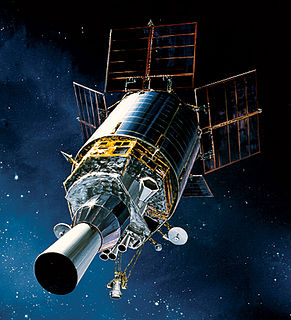
The Defense Support Program (DSP) is a program of the United States Space Force that operated the reconnaissance satellites which form the principal component of the Satellite Early Warning System used by the United States.

The Space-Based Infrared System (SBIRS) is a United States Space Force system intended to meet the United States' infrared space surveillance needs through the first two to three decades of the 21st century. The SBIRS program is designed to provide key capabilities in the areas of missile warning, missile defense and battlespace characterization via satellites in geosynchronous Earth orbit (GEO), sensors hosted on satellites in highly elliptical orbit (HEO), and ground-based data processing and control.
Lockheed Martin Space is one of the four major business divisions of Lockheed Martin. It has its headquarters in Denver, Colorado, with additional sites in Sunnyvale, California; Santa Cruz, California; Huntsville, Alabama; and elsewhere in the United States and United Kingdom. The division currently employs about 16,000 people, and its most notable products are commercial and military satellites, space probes, missile defense systems, NASA's Orion spacecraft, and the Space Shuttle external tank.

Minotaur-C, formerly known as Taurus or Taurus XL, is a four stage solid fueled launch vehicle built in the United States by Orbital Sciences and launched from SLC-576E at California's Vandenberg Air Force Base. It is based on the air-launched Pegasus rocket from the same manufacturer, utilizing a "zeroth stage" in place of an airplane. The Minotaur-C is able to carry a maximum payload of around 1458 kg into a low Earth orbit (LEO).
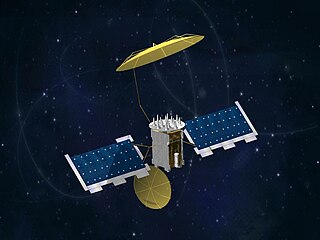
The Mobile User Objective System (MUOS) is a United States narrowband military communications satellite system that supports a worldwide, multi-service population of users in the ultra high frequency (UHF) band. The system provides increased communications capabilities to newer, smaller terminals while still supporting interoperability with legacy terminals. MUOS is designed to support users who require greater mobility, higher bit rates and improved operational availability. The MUOS was declared fully operational for use in 2019.
The Space Test Program (STP) is the primary provider of spaceflight for the United States Department of Defense (DoD) space science and technology community. STP is managed by a group within the Advanced Systems and Development Directorate, a directorate of the Space and Missile Systems Center of the United States Space Force. But STP is a DoD-wide organization. STP provides spaceflight via the International Space Station (ISS), piggybacks, secondary payloads and dedicated launch services.

The Delta IV Heavy is an expendable heavy-lift launch vehicle, the largest type of the Delta IV family. It is the world's second highest-capacity launch vehicle in operation, behind SpaceX's Falcon Heavy, and closely followed by CASC's Long March 5. It is manufactured by United Launch Alliance (ULA) and was first launched in 2004. ULA will retire the Delta IV Heavy in 2024. As of March 2022, three flights remain.
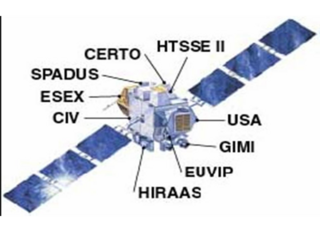
The Advanced Research and Global Observation Satellite (ARGOS) was launched on 23 February 1999 carrying nine payloads for research and development missions by nine separate researchers. The mission terminated on 31 July 2003.
The Space Tracking and Surveillance System (STSS) was a pair of satellites developed by the United States Missile Defense Agency (MDA) to research the space-based detection and tracking of ballistic missiles. Data from STSS satellites could allow interceptors to engage incoming missiles earlier in flight than would be possible with other missile detection systems. The STSS program began in 2001, when the "SBIRS Low" program was transferred to MDA from the United States Air Force. In December 2002, SBIRS Low Research & Development was renamed Space Tracking and Surveillance System (STSS).
The Space Based Space Surveillance (SBSS) system is a planned United States Space Force constellation of satellites and supporting ground infrastructure that will improve the ability of the United States Department of Defense (DoD) to detect and track space objects in orbit around the Earth. The primary SBSS contractor, Boeing, characterizes some orbiting space objects as, "Potential future threats to the United States' space assets".
Space Infrastructure Servicing (SIS) is a spacecraft concept being developed by Canadian aerospace firm MDA to operate as a small-scale in-space refueling depot for communication satellites in geosynchronous orbit.

USA-233, or Wideband Global SATCOM 4 (WGS-4) is a United States military communications satellite operated by the United States Air Force as part of the Wideband Global SATCOM programme, which was launched in 2012. The fourth Wideband Global SATCOM satellite, it is the first WGS Block II satellite to be launched. It is stationed at 88.5° East in geostationary orbit.

The Laser Communications Relay Demonstration (LCRD) is a NASA mission that will test laser communication in space for extremely long distances, between Earth and geosynchronous orbit.
On-orbit satellite servicing refers to refueling or repairing space satellites while in orbit.

JPSS-2, or Joint Polar Satellite System-2, is the second of the United States National Oceanic and Atmospheric Administration (NOAA)'s latest generation of U.S. polar-orbiting, non-geosynchronous, environmental satellites called the Joint Polar Satellite System. JPSS-2 is scheduled to be launched on 1 November 2022 and join NOAA-20 and Suomi NPP in the same orbit. Circling the Earth from pole-to-pole, it will cross the equator about 14 times daily, providing full global coverage twice a day.

NOAA-20, designated JPSS-1 prior to launch, is the first of the United States National Oceanic and Atmospheric Administration's latest generation of U.S. polar-orbiting, non-geosynchronous, environmental satellites called the Joint Polar Satellite System. NOAA-20 was launched on 18 November 2017 and joined the Suomi National Polar-orbiting Partnership satellite in the same orbit. NOAA-20 operates about 50 minutes ahead of Suomi NPP, allowing important overlap in observational coverage. Circling the Earth from pole-to-pole, it crosses the equator about 14 times daily, providing full global coverage twice a day. This will give meteorologists information on "atmospheric temperature and moisture, clouds, sea-surface temperature, ocean color, sea ice cover, volcanic ash, and fire detection" so as to enhance weather forecasting including hurricane tracking, post-hurricane recovery by detailing storm damage and mapping of power outages.

RSat-P is a microsatellite built by the United States Naval Academy (USNA) in Annapolis, Maryland. The small spacecraft is a 3U CubeSat intended to demonstrate capabilities for minor in-orbit repair of a much larger, conventional spacecraft.
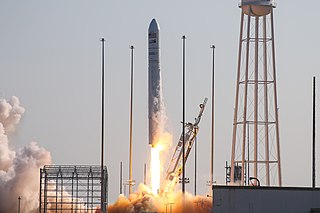
Cygnus NG-16, previously known as Cygnus OA-16, was the sixteenth flight of the Northrop Grumman robotic resupply spacecraft Cygnus and its fifteenth flight to the International Space Station (ISS) under the Commercial Resupply Services (CRS-2) contract with NASA. The mission was launched on 10 August 2021 at 22:01:05 UTC, for a (planned) 90-day mission at the ISS. This was the fifth launch of Cygnus under the CRS-2 contract.
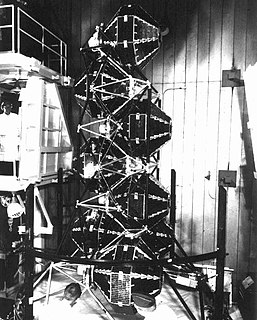
The Initial Defense Communications Satellite Program or IDCSP was the first United States Department of Defense communications satellite constellation and the first stage of the Defense Communications Satellite Program (DCSP). Launched in five groups by Titan IIIC launch vehicles to near equatorial, subsynchronous orbits between 1966 and 1968, they were intended to be experimental testbeds. They were so successful that, by the time of the launch of the last set of eight satellites, the IDCSP was deemed operational and renamed Initial Defense Satellite Communications System or IDSCS. This system allowed real-time collection of battlefield intelligence during the Vietnam War. A total of 35 IDCSP satellites were launched, 27 successfully.















